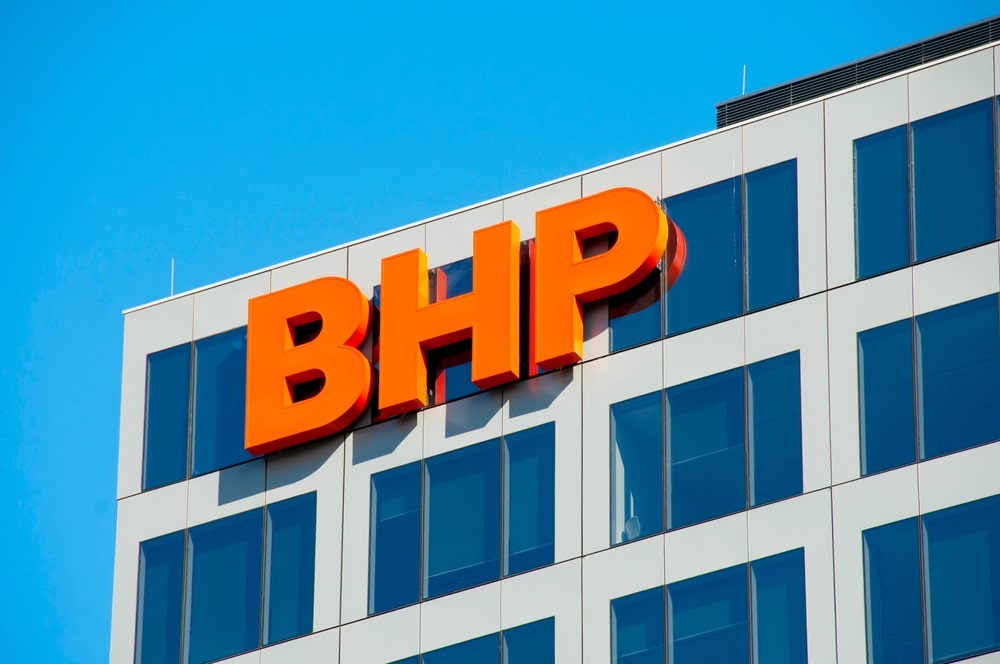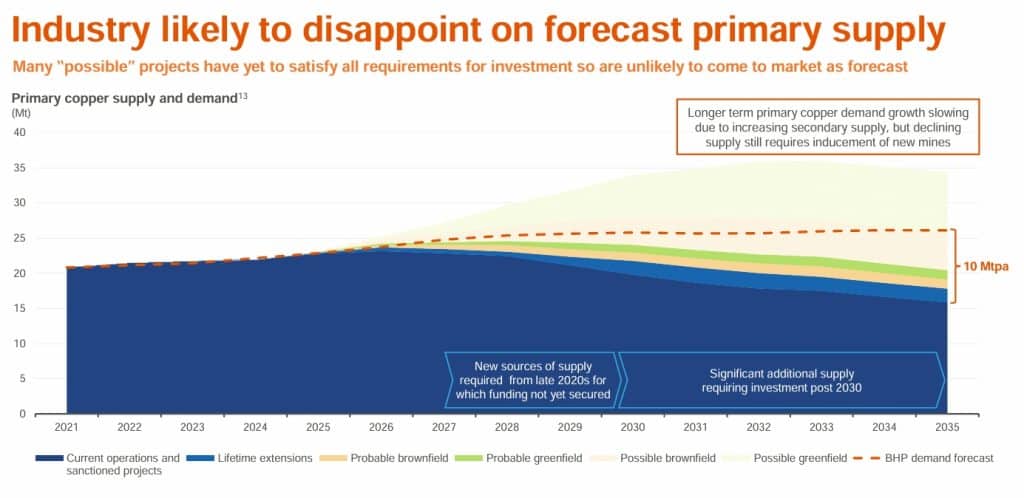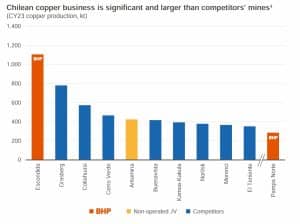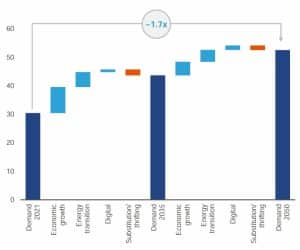BHP has set ambitious plans for its largest copper mine i.e. its Escondida mine and other operations in Chile, with investments ranging from $10.7 billion to $14.7 billion over the next decade. The mining giant aims to address declining ore grades and prepare for the eventual closure of the Los Colorados plant. The Escondida mine plays a significant role in this strategy, with its upcoming projects projected to initiate production between 2027 and 2032.
BHP Americas president Brandon Craig told Reuters in a recent interview,
“We think the deficit is going to be around 10 million tons by 2035.”
He further estimated a $250 billion cost to develop enough mines to match demand and hailed it as quite a challenging task for mining companies.
Source: BHP
Escondida: BHP’s Copper Catalyst
Located in the Atacama Desert of Northern Chile, Escondida, the largest copper mine lies 170 km southeast of Antofagasta. Escondida in Spanish means “hidden,” which is synonymous with the copper deposit that’s buried under hundreds of meters of overburden. The mine feeds three concentrator plants and two leaching operations, producing copper essential for global industries.
BHP owns a 57.5% stake in Escondida, with Rio Tinto holding 30% and JECO Corp controlling the remaining 12.5%. Their joint efforts have made Escondida a vital player in boosting Chile’s GDP.
We also discovered from its corporate deck that BHP’s Chilean mine has delivered 38 million tons of copper since 1990 which accounted for 7% of global copper mine output.
BHP’s Chilean Copper Dominance
Source: BHP
To address declining ore grades, BHP plans to expand its processing facilities and implement advanced copper extraction technologies. For example, introduce leaching technologies to extract copper from sulfide ores.
The company will launch four new projects at Escondida, starting between 2027 and 2032, with peak investments expected during fiscal years 2030 and 2031.
Key Projects Supporting BHP’s Investment Plans
Let’s take a look at the investment breakup as outlined by MINING.COM.
- The new concentrator will have a capacity of 220,000 and 260,000 tpa from 2031 or 32, with an estimated capital budget of $4.4 billion to $5.9 billion.
- Expand production at Laguna Seca by 50,000 to 70,000 tpa starting in 2030/31, with an investment of $2 billion to $2.6 billion.
- New leaching facilities will add ~ 35,000 to 55,000 tpa from 2030/32 onwards, requiring a capital expenditure of $900 million to $1.3 billion.
- The Los Colorados facility will continue operations until fiscal year 2029, maintaining an output of 130,000 to 145,000 tpa before its scheduled closure.
- Allocate $2.8 billion to $3.9 billion for its Pampa Norte division, which includes the Spence and Cerro Colorado mines.
- Boost production at Pampa Norte by 125,000 to 155,000 tpa. Restart the Cerro Colorado mine, using supergene leaching to deliver 85,000 to 100,000 tpa.
Through these investments, the company expects to stabilize production at 1.4 Mtpa by the early 2030s and maximize output from Chile’s copper-rich regions, including Escondido.
With these strategies and rationale, BHP aims to overcome the challenges of depreciating ore grades and increasing project complexities. Significantly, the investment, ranging between $10 and $14 billion, will be at a capital intensity of $23,000 per tonne of copper equivalent (CuEq) to achieve its targeted expansion plans.
BHP’s Copper Output: Meeting the Demand Surge
Copper, a pinkish-orange metal known for its exceptional conductivity and non-corrosive properties makes it a daily life metal. It’s widely used in electrical systems and has antimicrobial properties as well. The global copper demand is projected to rise in the coming years, but BHP has warned of a possibility of a 10mmt supply deficit by 2035.
Chile, the world’s largest copper producer, contributes 28% of the global supply annually. BHP’s operations contribute solely to 27% of Chile’s copper output.
- In 2023, BHP produced 1,716 kilotons (Kt) of copper. The company forecasted global demand to be approximately 2X in the next 30 years.
The rising demand for copper will be driven by the global energy transition and advancements in technology. Particularly by the growing adoption of electric vehicles and the rapid expansion of data centers.
Copper demand is projected to grow ~70% through to 2050.
(Copper semis end-use demand by key theme, Mt)
Source: BHP
Streamlined Operations and Strategic Advantages
Further putting the expansion plans into perspective, BHP expects to boost copper production by 430,000 to 540,000 tpa in its Chile operations. It shows the company’s adeptness in streamlining its operations and managing fewer but larger assets by efficiently using its infrastructure and workforce.
Being a pioneer in mining, it has time and again proved its deep geological knowledge to minimize technical risks while exploring low-risk brownfield opportunities.
Even though the global copper industry faces significant challenges, with a looming supply deficit nearly equal to 50% of today’s production, BHP remains committed. It’s adopting new technologies over time and fostering strong, mutually beneficial relationships with stakeholders to ensure sustainable growth amid market downturns.
As outlined earlier, by investing heavily in advanced technologies and strategic expansions, BHP ensures Escondida remains a critical pillar of the global copper supply and continues supporting the world’s current and future energy transition goals.
Data sources:
- BHP to spend up to $14bn in Chilean copper expansion – MINING.COM
- BHP bets billions on Chile mines to face global copper crunch – MINING.COM
- BHP 2024 Chilean copper site tour
- FURTHER READING: Nornickel’s Big Copper Bet: Will It Disrupt China’s Smelting Power?





